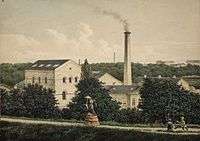Copenhagen Waterworks
Copenhagen Waterworks (Danish: Københavns Vandvlrk) opened in 1859 in Copenhagen, Denmark. Located in Studiestræde, between Axeltorv and H. C. Andersens Boulevard, it was Denmark's first waterworks and continued opeations until 1951. The complex was designated an Industrial Heritage Site in 2007 and listed in 2010. The former engine house is now home to the concert venue Pumpehuset. The other buildings houses a daycare.
History

Copenhagen's water supply was until the second half of the 19th century based on surface water from Damhus Lake. A dam on Harrestrup Å at Roskilde Road made it possible to lead water through Grøndalsåen and Ladegårdsåen to Sortedam and Peblinge Lakes.[1]
Copenhagen Waterworks was one of the first buildings to be built outside Copenhagen's old city walls. Its construction on a former ravelin has determined the arrangement of the individual buildings, which appears random today. A commission was set up in 1847 to investigate possible improvements of Copenhagen's water supply but it took the 1853 Copenhagen cholera outbreak to make the politicians take action. The British company Cochrane & Co was charged with the design and construction and overall design of the system while the architect Niels Sigfred Nebelong designed the individual buildings .Cochrane & Co had previously also constructed of the city's first gasworks.[2] Carlsberg-founder J. C. Jacobsen set the foundation stone on 16 May 1857 and waterworks was inaugurated on 9 August 1859.
The new pumping station contained three large steam engines drove the pumps. They produced a combined capacity of 300 hp. It extracted water from the lakes around Copenhagen as well as ground water and used an elevation resservoir in Søndermarken The capacity was increased in 1875 and 1889. The waterworks ceased operations in 1951.
Architecture
The original buildings are all in yellow brick with arched windows and have slate roofs. The pumping station is located in the centre of the site and consists of a two-storey machine house and a one-storey kettle house that are attached to each other as well as a small coal house on the south side of the kettle house. The chimney is from 1929. It was originally 43 m high but it was shortened by 10 m for security reasons.[3]
The other buildings are residences for the inspector and technical employees, a half-timbered gatehouse (1887, Ludvig Fenger) and three administration buildings the youngest of which is from 1951.
Today
The music venue has used the central pumping station since 1987. The other buildings are under transformation into a kindergarten.[2]
References
- ↑ "Det gamle København i bogform" (in Danish). Vanløse Bladet. Retrieved 2013-01-04.
- 1 2 "Københavns Vandværk" (in Danish). Kulturstyrelsen. Retrieved 2014-01-04.
- ↑ "11 Københavns Vandværk" (PDF). Kulturstyrelsen. Retrieved 2014-01-04.
External links
- første vandværk, text and images
Coordinates: 55°40′36″N 12°33′52″E / 55.6768°N 12.5645°E